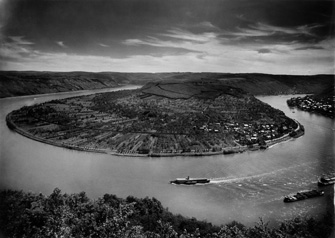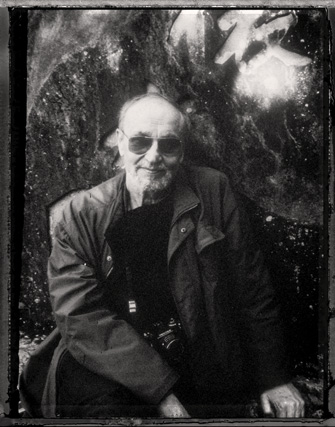 |
|
“Perspective of Trees,Tsarskoe Selo, Russia” (1999).© Michael Kenna |
I have always wanted to become a good photographer so that I could capture certain magical, fleeting moments – when the light hits a building or …
 |
|
“Perspective of Trees,Tsarskoe Selo, Russia” (1999). © Michael Kenna |
I have always wanted to become a good photographer so that I could capture certain magical, fleeting moments – when the light hits a building or a cloud in a particular way, for example – but I have never succeeded. When I saw Michael Kenna’s photos in the current exhibition at the Bibliothèque Nationale de France (through January 24), I felt as if he had done it for me. His best photos have the same effect as those real-life moments I wish I could imprison in a camera and print on paper to be admired forever after.
Kenna might be called a modern romantic; there is great poetry in his always black-and-white, always people-free images of nature and human constructions. Many of the former have a still, meditative quality, like “Night Lights,” a shot of the peaks of Rio de Janeiro at night taken from on high, while the latter manage to find beauty in what we most often consider ugly: factories, nuclear reactors, etc. Very rarely, he lets a little sentimentality slip in, as in “Invitation to Prayer” (1994), an image of a flying dove taken in Mont Saint Michel, but most of the time his images take your breath away with their studies of pearly light, deep shadows and contrasting textures. One of my favorites is “Schoolyard” with its jagged flash of white chalk line cutting through the pitch-dark setting. If you love photography, do see this show.
While Kenna’s work is timeless and people-free, the 100 or so photos by August Sander (1876-1974) in the current exhibition of his work at the Fondation Henri Cartier-Bresson, “Voir, Observer et Penser” (through December 20) are very much concerned with people of a certain time and place.
 |
|
“Bend in the Rhine near Boppard” (1938). © Die Photographische Sammlung/SK Stiftung Kultur – August Sander Archiv, Köln; ADAGP, Paris, 2009. |
Some of Sander’s landscapes, which show a preoccupation with the forms of nature and effects of light similar to Kenna’s, but without the technical brilliance, are also included in the exhibition.
Sander was an adherent of the early-20th-century New Objectivity movement in Germany, whose members – among them Otto Dix (see last week’s article on Fauves and Expressionists) – reacted to the excesses of Expressionism by looking reality square in the eye. Sander showed a penchant for cataloguing, an archival approach that was continued after World War II by other German photographers like Bernd and Hilla Becher, who made portraits of factories and industrial sites as assiduously as Sander photographed “types” of people, by social class or profession.
Sander’s straightforward documentary approach to portraits – his subjects look directly at the camera from real settings, and the images have purely descriptive labels (doctor, lawyer, beggar, policemen, hod carrier, etc.) – can sometimes have dramatic effects: a man in a black overcoat and bowler hat looks like a pop-up figure against the gray background of an empty curving city street; a girl looking through the small window of a door in a circus caravan reaches though the window and rests her hand on the key of the door, as if about to make her escape; a bald pastry cook in his white smock is as round as a creampuff. Sander even echoes (probably unintentionally) Expressionist artists in his portrait of a bailiff (who had just evicted him from his apartment), who looks for all the world like one of George Grosz’s caricatures of fat cats.
Sander’s influence can be seen in the work of many portrait artists who came after him, including Diane Arbus, but Sander’s subjects are never treated as freaks; even though they might be social outcasts like amputees or beggars, they always retain their dignity.
Rather than focusing on a single photographer, the Maison Européenne de la Photographie is paying homage to a man who can be largely credited with giving photography its lettres de
 |
|
Portrait of Robert Delpire by Sarah Moon. © Sarah Moon. |
noblesse in France. During his long career, Robert Delpire, the subject of “Delpire & Cie” (through January 24), has been a publisher, advertising man, film producer, director of the Centre National de la Photographie and more.
This show offers a sampling of his output, with mini-exhibitions of work by photographers and illustrators he championed, including Henri Cartier-Bresson and André Martin; examples of the many photography and other books he published, with original prints from some of them; clips from films he produced, including William Klein’s Who Are You, Polly Magoo? and Muhammad Ali: The Greatest; and examples of some of his daring advertising work, using many of the same artists he promoted, most notably Sarah Moon.
This portrait of a life’s work creates a portrait of a man with a mission – to elevate the status of photography while making it accessible to everyone (Delpire was behind the Photo Poche series of small, inexpensive but quality paperback books on the work of well over a hundred great photographers). What also shines through in this exhibition is a great curiosity about and love of faraway places and a strong streak of humanism.
Bibliothèque Nationale de France: 58, rue de Richelieu, 75002 Paris. Métro: Bourse or Palais Royal. Reservations: 0892 684 694 (FNAC). Open Tuesday-Saturday, 10 a.m.-7 p.m.; Sunday, noon-7 p.m. Closed Monday and public holidays. Admission: €7. Through January 24, 2010. www.bnf.fr
Fondation Henri Cartier-Bresson: 2, impasse Lebouis, 75015. Métro: Gaité or Edgard Quinet. Tel.: 01 56 80 27 00. Open Tuesday, Thursday, Friday and Sunday, 1pm- 6:30pm ; Wednesday, 11am-8:30pm ; Saturday, 11am-6:45pm. Admission €6 (free from 6:30pm on Wednesday). Through December 20, 2009. www.henricartierbresson.org
Maison Européenne de la Photographie: 5-7, rue de Fourcy, 75004 Paris. Tel.: 01 44 78 75 00. Métro: Saint Paul or Pont Marie. Open Wednesday-Sunday, 11am-8pm. Admission: €6.50. Through January 24, 2010. www.mep-fr.org
Buy related books and films from the Paris Update store.
More reviews of Paris art shows.
Reader Reaction
Click here to respond to this article (your response may be published on this page and is subject to editing).
© 2009 Paris Update
Favorite